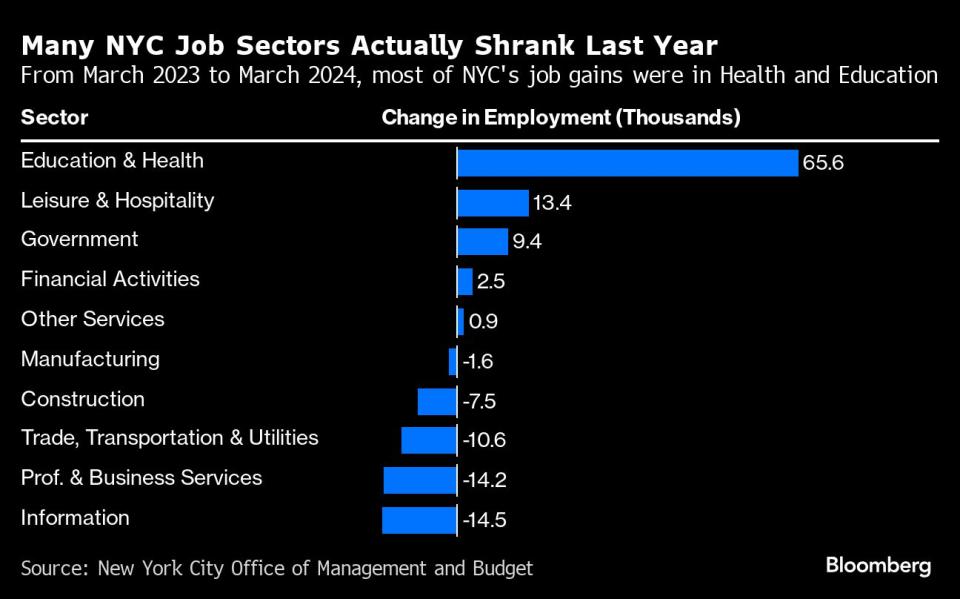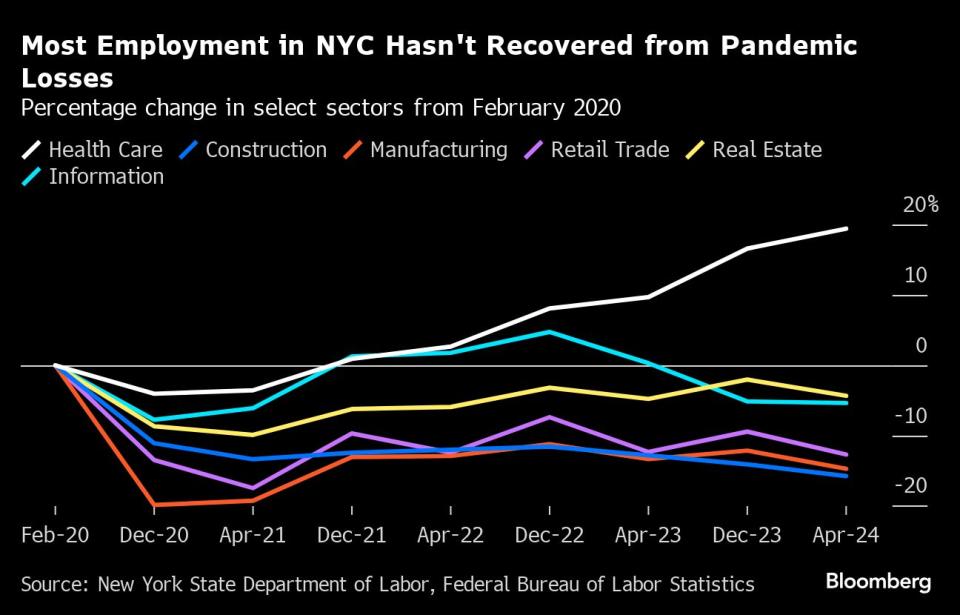NYC’s Job Boom Fueled by Taxpayer-Funded $38,280 Health Gigs
(Bloomberg) -- New York Mayor Eric Adams likes to boast that since he took office in January 2022, the city has regained all of the 300,000 jobs it lost during the pandemic. Local officials note that the city and its suburbs added more total jobs over the past year than any other metro area in the US.
Most Read from Bloomberg
Billionaire-Friendly Modi Humbled by Indians Who Make $4 a Day
Real Estate Investors Are Wiped Out in Bets Fueled by Wall Street Loans
A Struggling Business Park Deals a Blow to Singapore's Regional Hub Ambitions
But those gains are placing significant strain on city and state finances.
Virtually all of the jobs added in the 12 months ended in March were in home health care, a low-paying but rapidly swelling field. It’s technically classified as private employment, but home health care is actually paid for primarily through publicly funded health programs like Medicaid, where soaring costs are a looming threat to the New York state budget.
If not for the gains in home health care — where average annual wages statewide are $38,280 — the city’s total private-sector jobs would have contracted over the past year, city financial documents published in April show.
Excluding the “education and health” sector, where all of the growth was in health care, New York City lost 14,100 private-sector jobs in the year through March, according to city budget documents. The declines have been particularly acute in manufacturing, construction and professional and business services, which typically pay significantly higher wages.
“It’s giving us this sense that our economy is growing when in fact it’s really just Medicaid that’s growing,” said Bill Hammond, senior fellow for health policy at the Empire Center for Public Policy, a fiscally conservative think tank.
Economists attribute the astronomical growth in New York’s home health care sector to a state policy change made in 2015 that loosened eligibility rules for a Medicaid benefit known as the Consumer Directed Personal Assistance Program, or CDPAP. The program allows people eligible for home health care services to hire family members or close friends to care for them and be paid for their work through state Medicaid funds.
New York’s $111 billion Medicaid program, which provides health insurance to low-income residents, is among the largest in the country, with more than 7.5 million enrollees statewide, out of a total population of 19.7 million.
In the most recent fiscal year, the state paid for $35.9 billion of the Medicaid program, slightly more than 30% of the program’s total cost. Local governments, including New York City, contributed an additional $8.5 billion, while the federal government provided the other 60%, some $66.8 billion. In fiscal year 2023, New York City contributed $5.9 billion as its local share of the cost.
Relaxed Rules
The CDPAP program’s enrollment, workforce and total costs ballooned after the 2015 relaxation of eligibility rules, and ads promising people they can get paid to take care of elderly family members with few restrictions have become ubiquitous on city subway cars in recent years.
But the budget strain was compounded by New York’s rapidly growing elderly population, as the baby boom generation reached retirement age. The state has the fourth-largest population of older adults in the country, with 3.4 million residents age 65 and older out of 19.9 million residents.
Proponents of the CDPAP program point out that many of the caregivers being paid through it are people who would be doing the work of caring for family and friends anyway, as unpaid labor — part of a mostly female, invisible care economy in which 37 million Americans provide elder care each year with no remuneration.
New York state Medicaid spending on CDPAP alone has grown to an estimated $9.1 billion from $2.5 billion in 2019. And the number of people receiving care through the program has surged to 247,538 in 2023 from 19,512 in 2016.
Meanwhile, jobs in home health are making up an increasingly large share of the city and state’s overall economy. Between 2014 and 2024, home health aide jobs went from comprising 6% of New York City’s total private-sector jobs to 12%. The sector accounted for 57% of all private-sector job growth statewide over the past decade, said Hammond of the Empire Center.
Raising Alarms
Growth in the CDPAP program is also drastically accelerating New York’s total Medicaid spending, raising alarms among state officials about both the state’s ability to afford the costs and possible fraud.
Governor Kathy Hochul is “very concerned” about the rapid growth in the CDPAP program, state Budget Director Blake Washington said earlier this year.
“We’re concerned that what we’re doing here, by having widened the net so greatly, is we’re inviting abuses to the system,” he said. “We’re hurting the program that we value for the consumers that need it the most.”
The disproportionate growth in home health care shows that “there are still many private-sector economic recovery challenges that New York City needs to face,” said James Parrott, director of economic and fiscal policy at The New School.
Of the 330,700 non-seasonally adjusted jobs the city added since January 2022, 114,500, or 34%, have been in the home health care or individual and family services sectors, data from the federal Bureau of Labor Statistics show. That means that while the city has recently reached and exceeded its overall pre-pandemic jobs number, the composition of those jobs has changed significantly. Many of the city’s most important sectors still have far to go before they reach their pre-pandemic strength.
For example, construction jobs are still at 84.3% of pre-pandemic levels, and manufacturing, retail and wholesale trade positions have stalled out at about 85% to 95% of their February 2020 levels. Even jobs in industries conducive to remote work have yet to recover fully, BLS data shows. Jobs in the information sub-sector and in real estate are still at 95% and 96% of pre-pandemic levels, respectively, Parrott said.
“That’s not exactly a private-sector economic rebound,” Parrott said.
The Adams administration acknowledged that home health care made up the bulk of the jobs gained in the past year but said some other sectors have fully or nearly recovered. Economic development officials are working to boost job growth.
Officials also noted that the shift in the composition of New York City’s jobs has been a factor following other major economic crises, including the 9/11 attack on the World Trade Center and the 2008 financial crisis, when Wall Street jobs shrank and other sectors, like tech, began to grow.
A recent survey of New York City businesses conducted by the Partnership for New York City found room for optimism: Some 38% of employers surveyed expect to increase their headcount over the next 12 months, while just 10% said they anticipated needing to cut jobs.
“The Adams administration came into office with a mission to protect public safety, rebuild our economy and make the city more livable — and we’re delivering on that mission every day,” City Hall spokesperson William Fowler said in a statement. “To continue pushing our economic recovery forward, we need to use every tool at our disposal, including growing sectors that benefit from public-private partnerships.”
--With assistance from Alex Newman.
(Updates story published June 5 with a survey about headcount in penultimate paragraph. A previous version corrected percentages an economist provided on job recoveries.)
Most Read from Bloomberg Businessweek
Sam Altman Was Bending the World to His Will Long Before OpenAI
David Sacks Tried the 2024 Alternatives. Now He’s All-In on Trump
Startup Brings New Hope to the Pursuit of Reviving Frozen Bodies
©2024 Bloomberg L.P.

 Yahoo Finance
Yahoo Finance 


